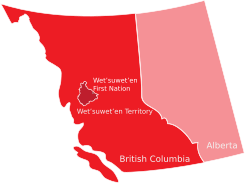Wetʼsuwetʼen First Nation facts for kids

Wetʼsuwetʼen First Nation location in traditional Wetʼsuwetʼen territory within British Columbia, Canada
|
|
| People | Dene |
|---|---|
| Province | British Columbia |
| Land | |
| Main reserve | Palling 1 |
| Other reserve(s) |
|
| Land area | 7.008 km2 |
| Population (2020) | |
| On reserve | 83 |
| On other land | 11 |
| Off reserve | 162 |
| Total population | 256 |
| Government | |
| Chief | Maureen Luggi |
| Council |
|
| Tribal Council | |
| Carrier Sekani Tribal Council | |
The Wetʼsuwetʼen First Nation is a First Nations community. It is located near the village of Burns Lake in British Columbia, Canada. This group is part of the larger Wetʼsuwetʼen people.
The community used to be called the Broman Lake Indian Band. Many people still refer to it as Broman Lake, even though its official name has changed. Members of the Wetʼsuwetʼen First Nation speak the Wetʼsuwetʼen dialect. This is a part of the Babine-Witsuwitʼen language, which belongs to the Northern Athabaskan language family.
The main part of the community is on a piece of land called Palling Indian Reserve No. 1.
Contents
About the Wetʼsuwetʼen First Nation
The Wetʼsuwetʼen First Nation is a self-governing group. They work to support their members and manage their lands. As of 2020, there were 256 registered members in total. About 83 members lived on their own reserve lands.
Community Leadership
The Wetʼsuwetʼen First Nation has a chief and council who lead the community. They make decisions for the group. The Nation is also a member of the Carrier Sekani Tribal Council. This council helps different First Nations groups work together.
How the Nation Formed
The Wetʼsuwetʼen First Nation was once part of a larger group called the Omineca Band. In 1984, the Omineca Band divided into two new groups. These were the Broman Lake Band (which became the Wetʼsuwetʼen First Nation) and the Nee-Tahi-Buhn Band. Later, the Skin Tyee band also formed from the Nee-Tahi-Buhn group.
Clean Water for the Community
For many years, the Wetʼsuwetʼen First Nation faced a challenge with their drinking water. A warning about the water had been in place since March 13, 2013. This was because arsenic was found in the water supply.
On March 18, 2021, this warning was finally lifted. This happened after a temporary water treatment plant was set up. There are also plans to build a more permanent system. The water warning had affected 24 homes and four other buildings in the community.
Other Wetʼsuwetʼen Communities
There are several other Wetʼsuwetʼen First Nations communities. These include the Burns Lake Indian Band, Hagwilget Village First Nation, Skin Tyee First Nation, Nee-Tahi-Buhn Band, and Witset.
See also

